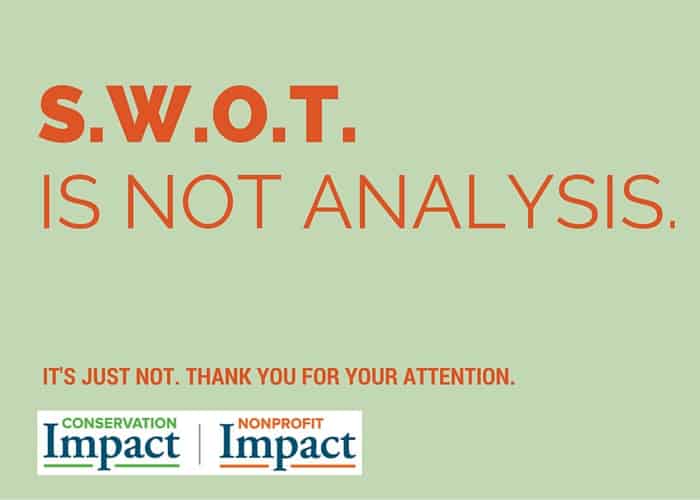
Organizational Analysis (or how to know what you need to know!)
Mission-driven organizations operate in a complex environment. Operating in isolation from the world around you is no longer an option. Economic, political, and technological trends all have an impact on how you do business. Effective leaders know how to tap into meaningful information about trends and issues that affect their organizations.
But information without analysis just leads to information overload. Honing your abilities around organizational analysis, which looks at internal and external factors and constituents in a systematic, objective manner, will ensure that you make solid, informed strategic decisions. Indeed, without good, solid analysis, any organizational decision risks being little better than a guess, or at worst, self-serving.
Scope and Scale
Analysis can be as simple paying attention to trends and issues and asking: What does this mean for us? Or, it can be as comprehensive as a process including interviews, focus groups, surveys, polls, and an in-depth review of the relevant literature. The scope and scale of an organizational analysis depends on an organization’s situation.
For one all-volunteer land trust, a group of board members discussed issues, trends, ideas, and stakeholders for a few hours and that discussion provided the basis for a solid analysis. This worked because the board members where diverse, active, and experienced in fields relevant to the land trust and because the land trust’s operating environment was relative stable and its organization was fairly small.
In another situation, the organization analysis required 100 phone interviews, several focus groups around the country, and extensive secondary research. For a larger, complex, nationwide organization, this more robust approach was appropriate and necessary.
Analysis Defined
You’re probably familiar with SWOT analysis (strengths, weaknesses, opportunities, threats). But SWOT is not analysis – it is a brainstorming exercise. It is limited to the knowledge and perceptions of those present for the brainstorming session, does not allow for input from external stakeholders, experts or constituents, and results in a laundry list of ideas.
The key to the organizational analysis process is just that – analysis. Good analysis provides meaning and interpretation to data and information, not just reciting facts and figures. It asks the question “so what?” Solid organizational analysis:
- Is objective
- Correlates internal and external factors
- Considers constituents
Objectivity
If analyzing your own organization, be clear about your biases, stereotypes, and expectations as they can shadow the data and information you consider. Depending on one’s perspective, we learn different things from the data and information. For example, the same data might reveal very different things to an economist, a sociologist, or a political scientist.
One way to enhance objectivity is to check your analysis with outsiders. If you are too close to the situation it is easy to see what you want to see or expect to see. When confronting particularly complex data, or a new situation, it is helpful to bring in others with different perspectives to enhance our understanding.
Inside and Outside
Taking stock of an organization’s internal situation reveals part of the picture. For example, a land trust may find that in the past year, it has experienced a 2% increase in membership, conserved no additional land, and maintained a flat budget. This provides a snapshot of the land trust’s current situation. But is that situation good or bad?
The only way to gauge what the current situation really means is to understand relevant external factors. For example:
- Has the population in the service area grown or shrunk?
- Is there increased competition from other nonprofit organizations for funding?
- How are larger economic trends affecting the local community?
- Has there been any change in how community members perceive their land conservation needs?
Bringing together internal and external information illuminates the situation fully. This kind of organizational analysis helps you understand your successes, gauge opportunities, and see new ways to calibrate your work to increase your results.
Constituent-Centered
As a nonprofit organization, you have core constituents – donors, supporters, clients, stakeholders. Essentially, your constituents are those individuals and entities that care enough about your work to take significant action on your organization’s behalf. Without your constituents, your organization would not exist. Thus, your organizational analysis needs to consider your constituents’ perspective and input, whether directly (e.g., through interviews, focus groups, polls, etc.) or indirectly (e.g., by looking at the information and analysis from constituents’ perspective).
Analysis requires critical thinking to look at the sum of information and makes connections and correlations that add new meaning. This is a skill that takes practice and concentration, but the more often you work your analysis muscles, the stronger that skill will get and the better able you will be to use information in a meaningful way to make your organization more successful.

